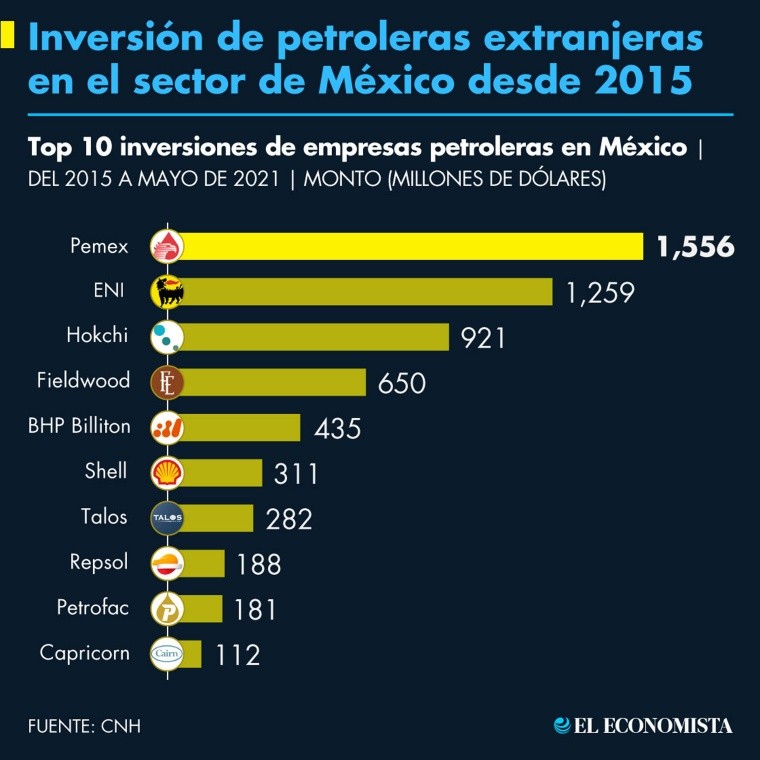The shallow water fields Amoca, Miztón and Tecoalli, which make up one of the largest private oil contracts in the country, operated by the Italian National Hydrocarbons Authority (ENI), fell below the desired pressure, reaching a critical moment with which they will produce more gas, increasing their costs, lowering their oil production and preventing the gas exploitation goals from being reached.
Therefore, the National Hydrocarbons Commission (CNH) on Tuesday rejected the modification to the development plan and the 2021 plan and budget for this contract, since the estimates presented by the company were not consistent with reality and it was their own delays in activities that led them to this situation that reduces the profitability of hydrocarbons for the State.
To say of President of the CNH, Rogelio Hernández Cázares, there was the arrival of a floating production, storage and unloading vessel (FPSO) a year ago, which would start the second stage of exploitation of the deposit until 2041. Now, it will be until March 2022 the arrival of this infrastructure fundamental to continue with the plans presented by ENI, which has damaged the field where it will cost more time and money to extract oil.
It gives me the impression that they have a plan already made and want to continue with it without seeing the reality of the deposit, ”explained Commissioner Héctor Moreira in this regard.
The plans presented at the 91st session of the regulator’s governing body remained in line with the same expectations prior to this drop in production as determined by the CNH’s analyzes, which rejected ENI’s plans until the necessary adjustments were made.
For now, ENI must present a new plan and budget for 2021 before being able to continue with its plans for 2022. At the same time, it stays with its previous development plan and if it falls into breaches, it will pay the penalties provided for in its contract.
And it is that the budget for 2021 increased from 374.6 to 534.7 million dollars for this year, an increase of 43%, than in a shared production contract where costs that the State as a partner must pay can be deducted. Some of the costs in the geology activity come from the market comparisons that the CNH carries out, they explained during the session of the governing body.
According to Francisco Castellanos Paez, director of the CNH’s Technical Extraction Unit, ENI explained to the regulator that they have had delays in their production derived from the fact that the arrival of the ship was postponed due to technical circumstances and others associated with the pandemic. In addition, ENI proposed a water injection strategy to accelerate production, with which delays due to situations outside the field have also caused physical impacts in the area that have reduced the extraction of hydrocarbons.
This contractual area has an area of 67.2 square kilometers and was awarded on November 30, 2015 in the second tender of Round One of the past administration. It has a hydrocarbon extraction contract under the shared production modality, operated 100% by the Italian Ente Nazionale Idrocarburi, in the Amoca, Miztón and Teocalli fields, in shallow waters of the Gulf of Mexico, where mainly black oil can be extracted.
It has two development phases until 2041, the early production until March 2022, when a floating production, storage and offloading vessel (FPSO) will arrive to start the second stage.
The technology within the best practices is adequate, but their production forecasts do not contemplate the current behavior of the field and with two years of production they should already reflect it in their plans, in addition to having exceeded costs and releasing more gas than they are. considering, while with the information presented they do not give certainty that this will be their behavior, in addition to that it seems that they will produce condensate but they do not have measurement mechanisms to report it.
The Italian oil company National Hydrocarbons Authority It reached October with a crude oil production volume of 10,000 barrels per day less than estimated in a program that it actually maintains for 2022, in which it continues to estimate that its volume to be recovered for this year will be 7.8 million barrels.
In terms of investments, it goes from a current plan of 7,528 million dollars, which includes the 738 million dollars that were invested in 2019 and 2020 and the 513 million that have been spent so far in 2021, to a programmed investment of 8,194 million dollars over the life of the field, according to the new plan, increasing its expenses by 8.8% or 666 million dollars. For development and production activities, an expense of 6,879 million is contemplated and of this 76% is for the production of the field.
The activity has variations because some have already started and others have had to be deferred, they explained during the 91 session of the CNH governing body, although in terms of extraction volume, they go from a plan of 347 million barrels (of which have taken 7.6 million) to 343.3 million barrels, lowering their forecasts for crude oil by 4 million barrels, while for gas they lower their forecasts at 222,000 million cubic feet (of which they have extracted 7,200 million cubic feet) .
In October, the field operated by the Italian ENI in the Miztón field had an extraction of 14,625 barrels per day, with a reduction of 1% per month and 13% per year. In recent times we see that it has a downward production behavior, since according to the CNH production reports in one year the extraction decreased by 13%, although last July it rose again to 19,586 barrels per day, which are more than 5,000 barrels per day of what it produced in the last October report.

Reference-www.eleconomista.com.mx